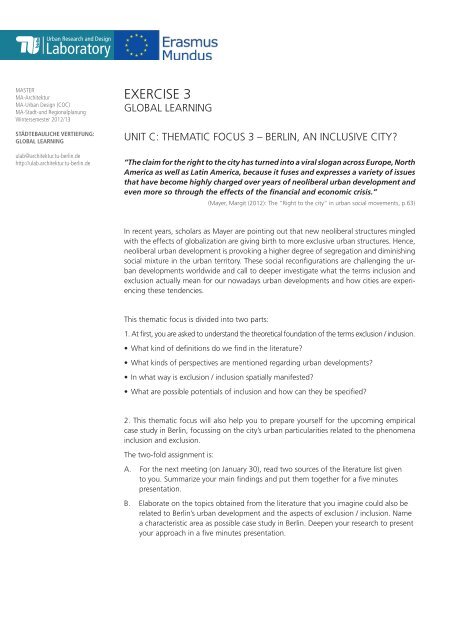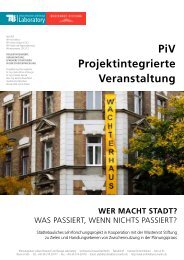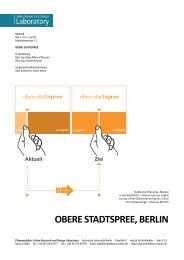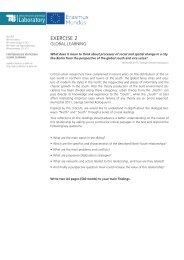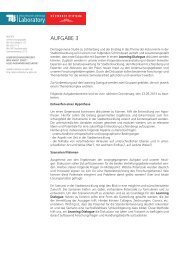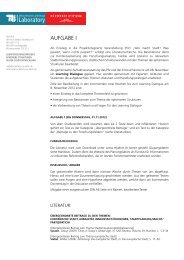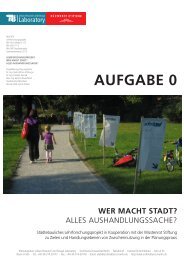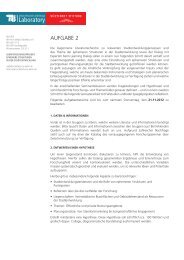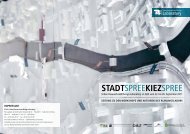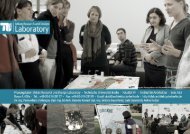Laboratory - Urban Research and Design Laboratory - TU Berlin
Laboratory - Urban Research and Design Laboratory - TU Berlin
Laboratory - Urban Research and Design Laboratory - TU Berlin
You also want an ePaper? Increase the reach of your titles
YUMPU automatically turns print PDFs into web optimized ePapers that Google loves.
<strong>Urban</strong> <strong>Research</strong> <strong>and</strong> <strong>Design</strong><br />
<strong>Laboratory</strong><br />
MASTER<br />
MA-Architektur<br />
MA-<strong>Urban</strong> <strong>Design</strong> (COC)<br />
MA-Stadt-und Regionalplanung<br />
Wintersemester 2012/13<br />
Städtebauliche Vertiefung:<br />
global learning<br />
ulab@architektur.tu-berlin.de<br />
http://ulab.architektur.tu-berlin.de<br />
ExErcisE 3<br />
GLOBAL LEArNiNG<br />
UNit c: thEmAtic fOcUs 3 – BErLiN, AN iNcLUsivE city?<br />
“The claim for the right to the city has turned into a viral slogan across Europe, North<br />
America as well as Latin America, because it fuses <strong>and</strong> expresses a variety of issues<br />
that have become highly charged over years of neoliberal urban development <strong>and</strong><br />
even more so through the effects of the financial <strong>and</strong> economic crisis.”<br />
(mayer, margit (2012): the “right to the city” in urban social movements, p.63)<br />
in recent years, scholars as mayer are pointing out that new neoliberal structures mingled<br />
with the effects of globalization are giving birth to more exclusive urban structures. hence,<br />
neoliberal urban development is provoking a higher degree of segregation <strong>and</strong> diminishing<br />
social mixture in the urban territory. these social reconfigurations are challenging the urban<br />
developments worldwide <strong>and</strong> call to deeper investigate what the terms inclusion <strong>and</strong><br />
exclusion actually mean for our nowadays urban developments <strong>and</strong> how cities are experiencing<br />
these tendencies.<br />
this thematic focus is divided into two parts:<br />
1. At first, you are asked to underst<strong>and</strong> the theoretical foundation of the terms exclusion / inclusion.<br />
• What kind of definitions do we find in the literature?<br />
• What kinds of perspectives are mentioned regarding urban developments?<br />
• In what way is exclusion / inclusion spatially manifested?<br />
• What are possible potentials of inclusion <strong>and</strong> how can they be specified?<br />
2. this thematic focus will also help you to prepare yourself for the upcoming empirical<br />
case study in <strong>Berlin</strong>, focussing on the city’s urban particularities related to the phenomena<br />
inclusion <strong>and</strong> exclusion.<br />
the two-fold assignment is:<br />
A. for the next meeting (on January 30), read two sources of the literature list given<br />
to you. summarize your main findings <strong>and</strong> put them together for a five minutes<br />
presentation.<br />
B. Elaborate on the topics obtained from the literature that you imagine could also be<br />
related to <strong>Berlin</strong>’s urban development <strong>and</strong> the aspects of exclusion / inclusion. Name<br />
a characteristic area as possible case study in <strong>Berlin</strong>. Deepen your research to present<br />
your approach in a five minutes presentation.
<strong>Urban</strong> <strong>Research</strong> <strong>and</strong> <strong>Design</strong><br />
<strong>Laboratory</strong><br />
MASTER<br />
MA-Architektur<br />
MA-<strong>Urban</strong> <strong>Design</strong> (COC)<br />
MA-Stadt-und Regionalplanung<br />
Wintersemester 2012/13<br />
Städtebauliche Vertiefung:<br />
global learning<br />
ulab@architektur.tu-berlin.de<br />
http://ulab.architektur.tu-berlin.de<br />
rEADiNGs<br />
Please be reminded that you can find the readings on our myDrive-plattform.<br />
Gerometta, Julia et al. (2005): social innovation <strong>and</strong> civil society in <strong>Urban</strong> Governance:<br />
strategies for an inclusive city, in: <strong>Urban</strong> studies, vol. 42, No. 11, October 2005, pp.<br />
2007–2021.<br />
häußermann, harmut <strong>and</strong> Kapphan, Andreas (2002): <strong>Berlin</strong>. von der geteilten zur<br />
gespaltenen Stadt? Sozialräumlicher W<strong>and</strong>el seit 1990, Leske + Budrich.<br />
(german language, book available at VW-Bibliothek, several focus-chapters)<br />
häußermann, harmut; Kronauer, martin <strong>and</strong> Gornig, martin (2008): Desintegration und<br />
soziale Kohäsion in <strong>Berlin</strong>, Düsseldorf hans-Böckler-stiftung.<br />
(german language, focus-chapter 4)<br />
King, Anthony, D. (2000): Postcolonialism, Representation, <strong>and</strong> the city, in: Watson,<br />
Sophie <strong>and</strong> Bridge, Gary (eds.): A companion to the city, Blackwell, pp. 261–269.<br />
King, Anthony, D. (2009): Postcolonial Cities, pp. 1–6.<br />
Robinson, Jennifer (2011): Cities in a World of Cities. The Comparative Gesture, in:<br />
international Journal of <strong>Urban</strong> <strong>and</strong> regional research, volume 35.1, January 2011<br />
Robinson, Jennifer (2002): Global <strong>and</strong> World Cities. A view from the map, in:<br />
international Journal of <strong>Urban</strong> <strong>and</strong> regional research, vol. 26.3, september 2002, pp.<br />
531–554.<br />
roy, Ananya (2011): slumdog cities. rethinking subaltern <strong>Urban</strong>ism, in: international<br />
Journal of <strong>Urban</strong> <strong>and</strong> regional research, vol. 35.2, march 2011, pp. 223–238.<br />
slater, tom (2012): missing marcuse. On gentrification <strong>and</strong> displacement, in: Brenner, Neil<br />
et al. (eds.): Cities for people, not for profit, New York Routledge, 2012, pp.171–196.<br />
Watson, Vanessa (2008): Seeing from the South: Refocusing <strong>Urban</strong> Planning on the<br />
Globe’s Central <strong>Urban</strong> Issues, in: <strong>Urban</strong> Studies, Vol. 46, No. 11, October 2009, pp.<br />
2259–2275.<br />
Watson, Vanessa (2009): ‘The planned city sweeps the poor away. . .’: <strong>Urban</strong> planning<br />
<strong>and</strong> 21st century urbanisation, in: Progress in Planning 72, 2009, pp. 151–193.


